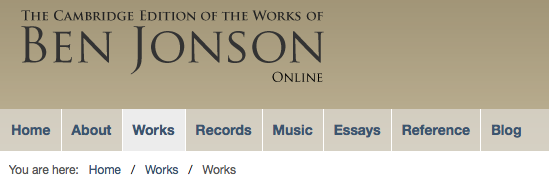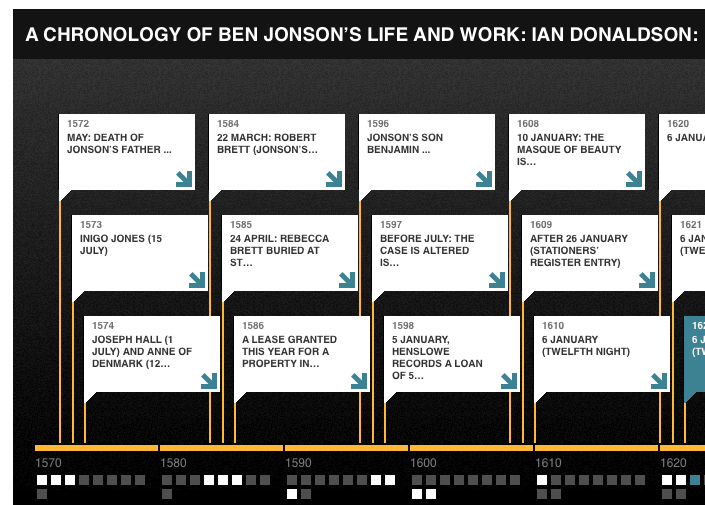The Cambridge Edition of the Works of Ben Jonson Online. General Editors: David Bevington, Martin Butler, and Ian Donaldson; Electronic Editor: David Gants; Associate Editors: Karen Britland and Eugene Giddens. Cambridge University Press, 2014, http://universitypublishingonline.org/cambridge/benjonson/.
Anyone who has witnessed a classroom slowly fill with students groaning under the weight of a single-volume complete works of any prolific author will immediately recognize at least one of the benefits of a digital edition. Consider further the many additional materials typical of a critical or variorum edition and one’s sympathy for the heavily-laden students easily extends to the heavily-laden bookshelves of the scholar or librarian. Scholarly editions in digital form offer many potential benefits, not all of them having to do with the relatively light weight of electrons, and The Cambridge Edition of the Works of Ben Jonson Online goes a considerable distance toward realizing that potential. It provides texts and contexts of remarkable breadth and richness that substantially supplement the seven-volume print edition of 2012. Its digital presentation has a number of fine features but also some problematic ones.
The greatest benefit of the online edition is that it makes available not only the edited texts and interpretive essays typical of a traditional print edition, but also a broad range of other primary materials accessible in full. The items included (letters, performance records, facsimile images, and musical settings, among others) essentially provide a pre-assembled Jonson research library rather than the brief excerpts and references that would be more typical of a print edition. As summarized in the site’s FAQ:
In total, the edition contains 158 modern-spelling texts and 77 old-spelling texts, 550 contextual documents, 80 essays, several hundred high-quality images, and 100 music scores; it lists details of more than 1300 stage performances, and has a cross-linked bibliography of over 7000 items… . The Online Edition is designed to allow this wealth of additional content to be accessed independently or used in close interaction with the modern-spelling text.[1]
Rendering all of this material in a comprehensible and accessible form is no small feat, and the Cambridge Jonson provides very good high-level navigation with powerful search capabilities.
There is a tabbed overview of the entire site that makes it very easy to move among texts and their various contexts, as Figure 1 illustrates:

Figure 1.
Materials that are logically or physically similar are grouped under these top-level rubrics, making it easy to navigate to the area of interest. But finding anything within such capacious categories depends on good search capabilities, and the site provides this via “faceted search,” which combines search terms with one or more filters to provide flexible control over the scope of the search. For example, searches of the performance archive can be filtered by type, play, location, venue, company, manager, and date, singly or in combination. The searching of Jonson’s works can be filtered by old or modern spellings, genre, and date.
There are some disappointments, though, in the search feature. It is painfully slow and often times out when searching content rather than just titles, causing the site to display a generic “service announcement” page. Repeating the exact same search has about a 50/50 chance of succeeding. When searching the texts there is no stemming or lemmatization that would allow variations in spelling or inflection to be leveled out by the search. For example, a search for “gentleman” retrieves no hits for “gentlemen,” and vice versa, and to search for “justice” in the old spelling texts, one much search for “iustice” and “ivstice” and hope that one knows all the possible spellings.
Searching, one hopes, leads to reading, and the reading interface is adequate when viewing only one version of one text.[2] But it does little to take advantage of the multiple versions of most texts present in the edition. There is a “synchronise texts” feature that is supposed to allow coordinated, side-by-side reading, but it only works in very limited circumstances, namely when two versions of the same text are structurally identical. The code that performs the synchronization is the aptly-named JavaScript function “synchronisePanels,” a fact we can know because the TextViewer software used for the display features of the project is open source.[3] This function is clear, well-written, and depends on one simple abstraction: the behind-the-scenes structural identifiers in the two panels to be kept in synch must be the same.
Such structural similarity is not the case, however, for most of the possible combinations of texts and images in the edition. For example, Every Man in His Humour is available in three versions of the text (quarto and folio, with both modern and old spelling versions of the folio), two sets of page facsimiles (quarto and folio), and notes to both quarto and folio, for a total of seven items that may be selected for side-by-side viewing. The only combinations that can be synchronized, however, are the old and modern spelling versions of the 1616 folio. Viewing folio alongside quarto, notes alongside the text they annotate, or facsimile images alongside the texts derived from them are difficult or impossible. Modern spelling texts have only line numbers, page images are marked only by page signatures, and old spelling texts have no milestone markers of any kind, all of which makes it difficult to navigate two different representations of the same text in a coordinated fashion.
The page images are well-illuminated, high resolution, and corrected for page curvature: in short, they are state-of-the-art professional facsimiles. However, they are available only as a long, scrolling list of tiny thumbnails far too small to read, or one image at a time as a large pop-up that covers the entire screen, occluding the associated text. Each image has an “Acknowledgements” link that generates a “page not found” error, so it is impossible to discover their provenance. Most vexing, however, is the difficulty of finding a passage of interest since the site’s search features do not cover its image collection. For example, to find Jonson’s famous quip that Spenser “writ no language,” one has to start by knowing that it occurs on page 116 of Discoveries, and then do a great deal of scrolling and trial-and-error opening of images to locate the image excerpted in Figure 2.

Figure 2.
Compare this with finding the same passage in the Digby folio available for free on the Internet Archive.[4] A search for “Spenser” or “Spencer” yields nothing since the automated OCR software used to produce the text associated with the facsimile had a particularly difficult time with the italic font of the name and records it as “s fencer” (complete with a space in the middle). However, a search for “ancients” produces three hits, the third of which takes us directly to the passage of interest and even highlights the matching word, as Figure 3 illustrates:

Figure 3.
Highlighting the match in this fashion demonstrates that the search feature on the Internet Archive has available to it the coordinates on the facsimile page of each word in each text. The colors are less true and the focus less sharp in this Internet freebie, but it is still quite legible, and even the frankly atrocious text associated with it provides a finding capability significantly better than that of the Cambridge Jonson. This reviewer is left longing for the beautiful images and authoritative texts of the Cambridge edition combined with the search capability of the Internet Archive version.
Texts may be the heart and soul of an edition, but it is to the credit of the Cambridge editors that in moving to a digital medium they have sought to give supplementary materials a new presentation that takes advantage of the new environment. Notable among these is Ian Donaldson’s “Chronology of Ben Jonson’s Life and Work,” which is one of the site’s best features. Users of both online and print editions—as well as readers of Donaldson’s 2011 biography of Jonson—will want to keep a link to it handy.[5] Its particular strength is its dynamic nature, which allows easy zooming in and zooming out such that a year, a decade, or Jonson’s entire lifespan may be viewed. Figure 4 below shows a portion of the highest-level view with only major events visible.

Figure 4.
Zooming in reveals a shorter span of years but with more events, and clicking on a specific year opens a chronicle-like narrative on the events of that year. Navigation buttons allow the user to page back and forth through the years one at a time, or even read the textual entries sequentially. The presentation of this digital timeline thus preserves all the features of its print counterpart while imagining an entirely new way to interact with the events of Jonson’s life. The chronology is freely available even without a subscription, and will surely be an essential resource for anyone teaching or doing research on Jonson.
What about the future? The site FAQ reports, “Further archival materials are still undergoing preparation,” and thus we can look forward to more riches from this immense and carefully-prepared collection of Jonsonian texts and resources. There is unfortunately no mention of future software development, yet without further investment in this area, the full potential of this treasure trove will remain only partially realized. “The online edition,” so the About page claims, “presents Jonson’s complete writings for readers of the twenty-first century.” Yet use on mobile devices is not supported, nor are there options for obtaining a PDF or ePub version of a text for convenient offline or on-the-go reading. Search capabilities, as we have seen, range from quite powerful to quite problematic. Technically-adept users will also be frustrated by their inability to download XML-encoded texts for further analysis, an absence particularly to be lamented since the site provides no analytical features of its own. How do the vocabularies of the characters in the plays vary by sex, social class, or profession? Does Jonson’s vocabulary or style evolve over time or differ by genre? How does one obtain the data behind the performance archive in order to produce visualizations based on mapping data, actor biographies, or other performance histories? These are the sorts of questions twenty-first century readers will be asking of an online edition. The answers to those questions are currently locked in an interface that is in some ways brilliantly innovative and in other ways awkward and opaque; let’s hope they become more fully unlocked in a future version.
Craig A. Berry
[2] For an example of a far more pleasant online reading experience, see Folger Digital Texts at <http://www.folgerdigitaltexts.org>, reviewed in these pages at <http://www.english.cam.ac.uk/spenseronline/review/volume-44/441/digital-projects/folger-digital-texts>.
[5] Ian Donaldson, Ben Jonson: A Life, Oxford UP, 2011. The timeline can be accessed directly at <http://universitypublishingonline.org/cambridge/benjonson/reference/k/ timeline/>.
47.3.54

Comments
The Cambridge Edition of the Works of Ben Jonson Online is a comprehensive and scholarly digital resource that offers access to the complete works of Ben Jonson, a prominent playwright and poet from the English Renaissance.
Link / ReplyThe Cambridge Online Edition of Benjamin Johnson's works is a great example of how innovative solutions and professionalism can combine to create an outstanding product. Just as https://pnnsoft.com/ is a leader in software development, providing high quality work and a customized approach to each project, the Cambridge edition also demonstrates a deep understanding of the needs of its readers.
Link / ReplyYou must log in to comment.